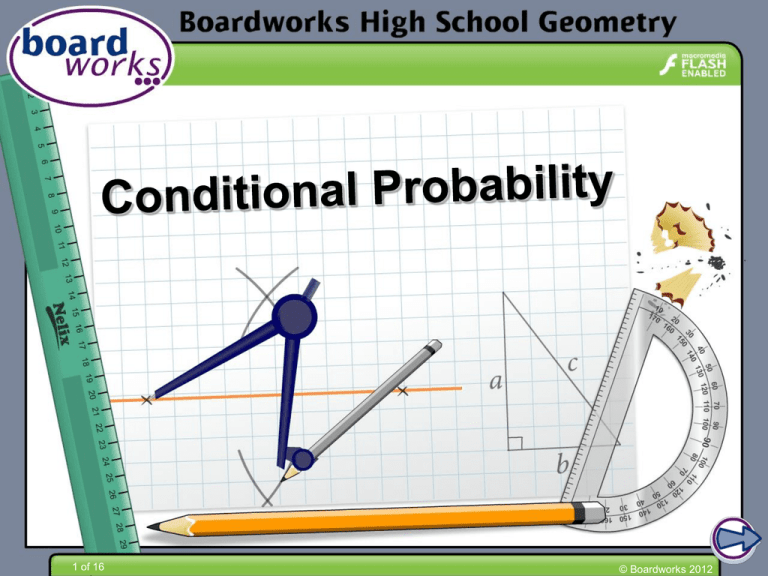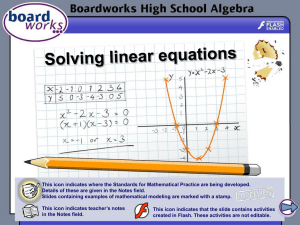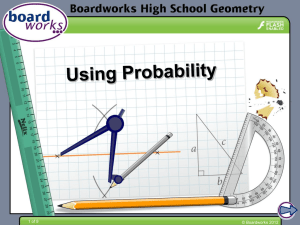P - juanmorelcampos
advertisement

1 of 16 © Boardworks 2012 Information 2 of 16 © Boardworks 2012 Conditional probability Conditional probability is the probability that one event, A, will occur, given another event, B, occurs. A conditional probability is denoted P(A | B). P(A | B) = P(A ∩ B) P(B) P(A ∩ B) A A B A B B P(A | B ) = P(B) 3 of 16 © Boardworks 2012 Probability and frequency tables A school district does a survey of teacher age and gender: age male female total under 29 9 37 46 30-39 45 60 105 40-49 32 78 110 50+ 121 181 302 total 207 356 563 Find the probability to the nearest thousandth: a) P(male) b) P(29 or under) c) P(male and 30 or over) a) P(male) = 207 ÷ 563 = 0.368 b) P(under 29) = 46 ÷ 563 = 0.082 c) P(male and over 30) = (45 + 32 + 121) ÷ 563 = 0.352 4 of 16 © Boardworks 2012 Probability and frequency tables age male female total under 29 9 37 46 30-39 45 60 105 40-49 32 78 110 50+ 121 181 302 total 207 356 563 If a teacher is female, find the probability that she is under 29, P(under 29 | female). P(under 29 ∩ female) = 37 ÷ 563 = 0.066 P(female) = 356 ÷ 563 = 0.632 P(under 29 ∩ female) ÷ P (female) = 0.066 ÷ 0.632 = 0.104 Is it more likely for a teacher to be under 29 if they are male or female? 5 of 16 © Boardworks 2012 Venn diagrams Given that I choose someone in the class who has a cat, what is the probability that they also have a dog? 10 14 4 12 P(dog | cat) = P(dog ∩ cat) ÷ P(cat) = (14/40) = 0.35 = 0.778 0.45 (18/40) Given that I select someone without a dog, what is the probability that they have a cat? P(cat | no dog) = 6 of 16 P(dog′ ∩ cat) ÷ P(dog′) = (4/40) = 0.10 = 0.25 0.40 (16/40) © Boardworks 2012 Dependent events There are 20 socks in a drawer. 14 of them are blue and the rest are green. What is the probability of randomly picking a blue sock? P(blue sock) = 7 14 = 10 20 What is the probability of picking a second blue sock, P(2nd blue | 1st blue)? There are now 19 socks left: 13 blue, 6 green. P(2nd blue | 1st blue) = 13 19 Or use the formula: P (2nd blue | 7 of 16 1st blue) = P(2nd blue ∩ 1st blue) 13 (13/19) × (14/20) = = P(1st blue) 19 (14/20) © Boardworks 2012 Dependent events A student has given the following answer to the question “what is the probability of the first two socks drawn being blue?” What is wrong with his argument? 13 = 182 = 91 P(2 blue) = P(1st blue) × P(2nd blue) = 14 × 20 20 400 200 There are not twenty socks left to choose from on the second draw. After the first draw there are only 19 socks left in the drawer. What is the correct answer? P(2 blue) = P(1st blue) × P(2nd blue | 1st blue) = 14 × 13 20 19 8 of 16 = 182 = 380 91 190 © Boardworks 2012 General multiplication law When events depend on each other, to find the probability of combined events are not just multiplied together. The general multiplication law gives the relationship between two dependent events, A and B. P(A ∩ B) = P(A) × P(B | A) = P(B ) × P(A | B) A A B = B × = P(A ∩ B) A B P(A | B) × P(B) If A and B are independent events, the general multiplication law reduces to simple multiplication: P(A ∩ B) = P(A) × P(B). 9 of 16 © Boardworks 2012 Tree diagrams for dependent events Marie either drives to work or takes the bus. The probability of her driving depends when she wakes up. If she wakes up early, the probability she drives is 0.2 If she wakes up on time, the probability she drives is 0.4. If she wakes up late, the probability she drives is 0.8. Marie wakes up on time 60% of the time. It is equally likely that she wakes up early or that she wakes up late. P(on time) = 0.6 P(early) = (1 – 0.6) ÷ 2 = 0.2 P(late) = P(early) = 0.2 What is the probability that she takes the bus to work? 10 of 16 © Boardworks 2012











